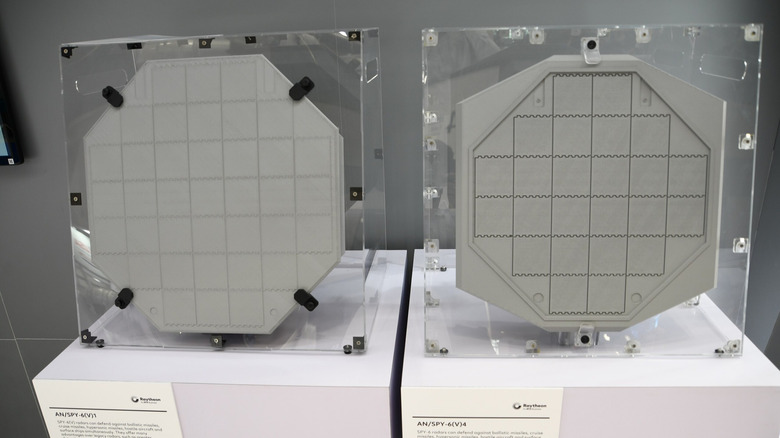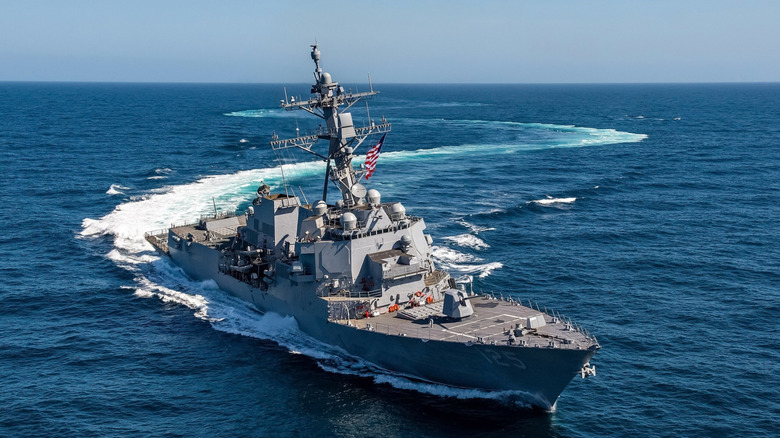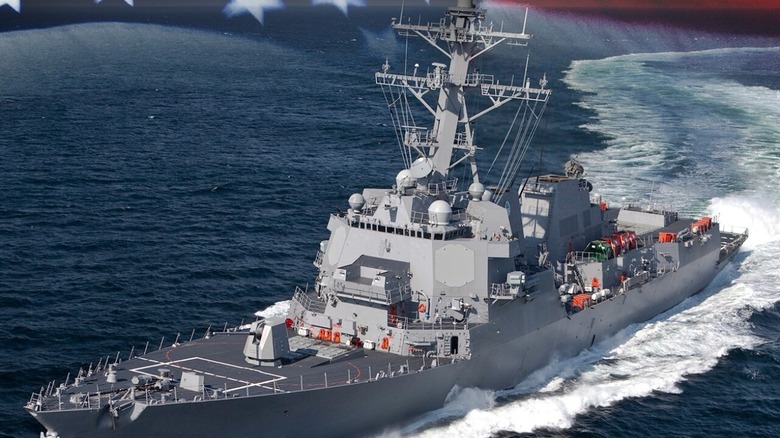The US Has A New Naval Destroyer With An Impressive Missile Detection System - Here's How It Works
From knights in heavy plate armor to tanks with steely shells, a thick armored casing alone was often sufficient protection in warfare for centuries. The advent of sophisticated missiles, though, has meant that even heavy armor can be penetrated. Even so, defensive capabilities have advanced right along with offensive ones.
The USS Louis H. Wilson Jr., a state-of-the-art missile destroyer coming to the U.S. Navy, seeks to overcome this threat by means of its formidable missile detection system. This destroyer was officially christened by the navy in September 2025, at General Dynamics Bath Iron Works. It's an Arleigh Burke-class Flight III destroyer, as opposed to a frigate, and this means that it'll boast one of the most advanced protective systems in the military: RTX's SPY-6, the AN/SPY-6(V)1 Air and Missile Defense Radar. This system is not only equipped to U.S. destroyers, but to a total of seven different ship classes in total. It can also be retrofitted onto older models, where possible.
It's a radar system with components that can be fitted together and therefore adapted to the size and needs of the vessel in question. Thisvital quality allows the system to be fitted to a naval fleet of dramatically different ships. The system of radars is connected together via its corresponding arrays, which are linked in turn to the AEGIS Combat System. SPY-6 itself, then, is not armed or a weapon system, but it is a critical element of an equipped ship's capacities as a whole. By feeding the information to the AEGIS, the Louis H. Wilson Jr. crew will be able to detect, identify, and track the danger it faces far more precisely, and quickly. This is a huge part of a U.S. Navy Destroyer's capability to strike targets at range.
How RTX's SPY-6 works
Attacks from the surface, from the air, and from different types of missiles (ballistic and hypersonic, for instance) could all put a vessel in peril. The virtue of the SPY-6 is that it's adaptable enough to respond to any of these. This system was introduced to the U.S. Navy in July 2020. It was procured firstly for the Jack Lucas, a Flight III Arleigh Burke-class destroyer, pictured here, and represents about a 30-fold boost over the capabilities of its predecessor, the SPY-1.
Raytheon Missiles & Defense's Wes Kremer told Defense News that it was "designed with incredibly long range and sensitivity to support all the missions that Navy destroyers do: ballistic missile defense, surface warfare and anti-air missions simultaneously." Of course, a robust defense such as this is only effective as long as it's not compromised by electronic warfare, and the SPY-6 was designed not to have its all-important coverage stopped by such interference.
A Destroyer's versatility gives it an edge both offensively and defensively. It can have a crucial protective role in carrier fleets, with its primary purpose being to ward off threats to aircraft carriers. These dangers can come from aircraft, submarines, or surface vessels, meaning that a destroyer needs to have the tools to counter all of these. To make it even more versatile, there are four different variants of the SPY-6 system. V1, which will be equipped by the USS Louis H. Wilson Jr., boasts four different radar array faces, with a different number of radar modular assemblies compared to variant four, which was also designed for destroyers. Version two and three are rotator and fixed variants of the Enterprise Air Surveillance Radar, which feature defensive boosts against carrier threats like cruise missiles as well as air traffic control compatibility.
What the USS Louis H. Wilson Jr. will bring to the fleet
The vessel itself, also known by its official designation of DDG-126, is being developed at General Dynamics Bath Iron Works. The keel for this particular model was laid back in May 2023. It is to be the latest model of the Arleigh Burke class of destroyers, which is the most numerous in the navy. In fact, in August 2025, there were 73 Arleigh Burke destroyers in service.
The Arleigh Burke guided missile destroyer was first deployed in 1985, and has grown to a huge class divided into several variants: Flight I, II, IIA, and III. USS Louis H. Wilson Jr. will be a Flight III destroyer, which will put its size at about 509.5 feet long, slightly larger than the Flight I and II variants. They're powered by a quartet of General Electric LM 2500-30 gas turbines and capable of traveling at speeds greater than 34.5 mph, which is particularly important: Its primary goal of defending aircraft carriers would be moot if it was unable to keep pace with them, after all.
Similarly, it's crucial that destroyers are equipped with formidable weaponry, and that's certainly the case for the broader Arleigh Burke family, among the most powerful destroyers in the world. They wield MK 48 torpedoes, along with Harpoon, Tomahawk, and RM missiles. Combined, this arsenal offers utility against airborne threats as well as those on and below the waterline, providing a robust threat against any foe the destroyer and its allies may encounter. With the additional flexibility to operate solo and defend itself effectively, these destroyers have much more than a niche role, and it's unsurprising that the U.S. is expanding its ranks with the USS Louis H. Wilson Jr.


